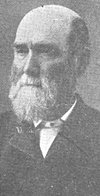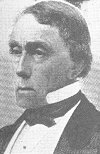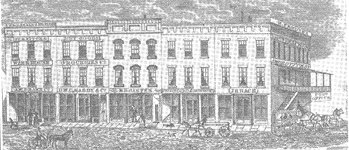|
EDWARD
O. Smith came west to "grow up with the
country." He not only did so, but he
helped the country to grow up. He has been
called the "builder of Decatur."

EDWARD O. SMITH
He was a builder in the material way, but he
was more than that -- he was a molder of the
destiny of the city. As a
contractor, he erected many of Decatur's
business and residence structures. As a
civic leader, he gave the city keen,
constructive service. He was resourceful
and courageous. He foresaw the future of
Decatur and he did a big parts in making that
future. As member of the state
constitutional convention, as state senator, as
mayor of Decatur, he served his state, his
district, his city.
The span of his life covered much more than
that of the ordinary man. Life in city and
village, in legislative halls, in deserts, from
east to west in this country, in foreign lands,
was his.
Edward O. Smith was born in Montgomery
county, Md., April 15, 1817. When still a
young lad, he went to Washington, D.C., where he
was employed for two years, and where he gained
much practical political knowledge.
With $19-- all the capital he had--in his
pockets, and with all his worldly effects in a
bundle across his shoulders, he started out on
foot, at the age of seventeen for the great
west.
When he reached Springfield, O., in the
course of his journey, he stopped for a time and
learned the carpenter's trade. After a
time, however, because of throat trouble he
decided to come farther west, to the prairies.
He stopped for a while in Montezuma, Ind., and
also in Terre Haute, Ind., then again he resumed
his westward way. He finally reached
Decatur. That was in May, 1837. By
that time the young man was twenty years old.
Here he stayed.
Decatur was not long in recognizing his
integrity and his ability as a contractor.
For the next twenty years he was a busy man.
Building after building he erected. He
succeeded in making money, and he invested it in
land, which he improved with more buildings.
Mr. Smith boarded at the Macon hotel,
and there he met Miss Harriet Krone,
daughter of the hotel keeper. He and Miss
Krone were married in 1843.*
Mr. and Mrs. Smith
became the parents of four sons and six
daughters, all of whom grew to manhood and
womanhood. Mrs. Smith
was a splendid helpmeet, and was a woman of good
business sense. When her husband was
absent in California, she carried on his
business here. Mrs. Smith died Jan.
16, 1867. Mr. Smith married a
second time, on April 15, 1869, the second wife
having been Mrs. Catherine Hillman of
Elmwood, Ill.
In 1847 Mr. Smith was elected to the
Illinois constitutional convention, and took an
active part in drafting the new constitution.
In 1848, he was elected state senator, being the
candidate of the Whig party.
One of his first acts as senator was to make
effort to secure federal donations of public
lands for the construction of the Illinois
Central and Northern Cross railroads. He
succeeded as far as the Illinois Central was
concerned, and land was donated to that road.
He was instrumental in securing other railroads,
including the Decatur and East St. Louis (now
St. Louis branch of the Wabash) and served as a
director of that road.
If it had not been for E. O. Smith,
the Illinois Central would have missed Decatur.
The route as first surveyed was six miles west
of the city. That route had been
considered the shorter and better route.
Mr. Smith got busy and through his efforts the
route was changed to come through Decatur.
Mr. Smith built Decatur's first opera
house. Many theatrical stars appeared in
Decatur during the regime of the Smith Opera
House.
Mr. Smith made several overland trips
to California in the days when a trip to the
west meant thrills and adventures. The
first was in 1852. The second trip was in
1858 at the time of the business depression in
Decatur. This journey was made by way of
New Mexico and Arizona, and was a most hazardous
undertaking. The party was attacked by
Indians a number of times and had other narrow
escapes from death. One time they traveled
86 miles without water. Mr. Smith
was away from Decatur three years on this trip.
When he returned in 1861 he was elected mayor of
the city, and held that office during part of
the critical Civil war period.
In 1870 Mr. Smith moved to California
and located in San Jose. He was soon
recognized in the western state as a man who
accomplished things, and he had the honor of
being elected to the constitutional convention
of that state. In 1889 he was able to
realize a desire he had long held, that of
taking a trip to Europe. Mr. Smith visited
Decatur a number of times after he located in
the west, but never came back to make his home.
He died suddenly of heart disease on March 8,
1892.
DR. J. T. B. STAPP
Dr. James Thomas Burbridge Stapp was
another of Decatur's builders, though of a later
date than Mr. Smith. He has been
referred to as Decatur's first real capitalist.
When he came here in 1855 he brought with him
$20,000 in cash.

DR. J. T. B. STAPP
Bringing such a sum of money to a country
that was almost dollarless, Dr. Stapp was
received as a man of importance. That
amount of money looked bigger then to Decatur
than a million dollars would look today.
Dr. Stapp was an aristocrat. He
was born in Woodford county, Ky., in the heart
of the blue grass country. The family
moved to Kaskaskia when Dr. Stapp was
only twelve years old. While still in his
teens the young man received an appointment as
clerk in the state auditor's office at Vandalia,
and he held that position for several years.
During the Black Hawk war Dr. Stapp
was aide-de-camp to General Reynolds. It
was through the acquaintance made then that he
was given the appointment as state auditor.
He was afterwards elected twice to that same
position.
He resigned as state auditor to become
cashier of the State bank of Illinois.
When the time came that the affairs of that
institution had to be wound up, it was necessary
for Dr. Stapp to transfer a wagon load of
silver to St. Louis. Nothing daunted by
the task, he loaded the silver on a wagon and
made the trip with only a pistol for defense.
In the Mexican war Dr. Stapp was
adjutant of the Third Illinois infantry.
He received an appointment as receiver of the
United States land office at Vandalia from
President Taylor and served in that
office under Presidents Taylor,
Fillmore and Pierce, resigning in
1855 to come to Decatur.
When Dr. Stapp first saw Decatur he did not
like it, and he said so.
"If you don't like it, why don't you go
somewhere else?" asked some one.
"I can do better than that," replied Dr.
Stapp. "I can stay here and help make
Decatur better."
That is just what he did.
Dr. Stapp bought the Henry Prather
residence at Franklin and William streets, which
was about the handsomest house in Decatur at
that time. Two sculptured lions, bought at
the Crystal palace in New York in 1866, guarded
the entrance to the home for many years.
Those lions served more purposes than one.
They were often used in giving directions.
They even aided the postman. One time a
letter came to Decatur addressed to a certain
person at "Mrs. McGinnis' boarding house,
two blocks east of where the lions are."
The letter reached its destination.
The lions have remained with us until this
day, although now they are reposing in front of
the Harkrader
place on Route 2, west side, about seven miels
north of Decatur.

STAPP'S ROW
Dr. Stapp and E. O. Smith built
Stapp's Row, a block of fie store buildings
on South Park street. They were three
stories high, and were the best and handsomest
business buildings in Decatur up to that time.
One night Dr. Stapp and J. R. Gorin
left a billiard game to go to a revival meeting
held by Rev. Levi C. Pitner, pastor of
the First Methodist church. Dr. Stapp,
who was converted at that revival meeting,
afterwards gave $5,000 toward the erection of a
new building for the Franklin street Methodist
church, then using a frame building on Franklin
street. The give was made on condition
that J. J. Peddecord
give half as much.
The new chapel was built at Eldorado and
Franklin streets northeast corner, and in honor
of the generous donor was called Stapp's
chapel for many years. After the
congregation, now called the Grace Methodist
church, erected a new building on North Man
street, the old chapel was sold to the Masons.
Dr. Stapp was a delightful man to
meet. He was always the gentleman, and he
had a keen and ready mind. He had once
studied medicine, but he never practiced the
profession. When Dr. Stapp passed
away in 1882, Decatur felt that it had lost a
real citizen.
<PREVIOUS> <NEXT>
<CLICK HERE TO RETURN TO TABLE OF CONTENTS>
* Marriage date of
5/19/1843 Macon Co., Illinois found in
Illinois State Archives
|